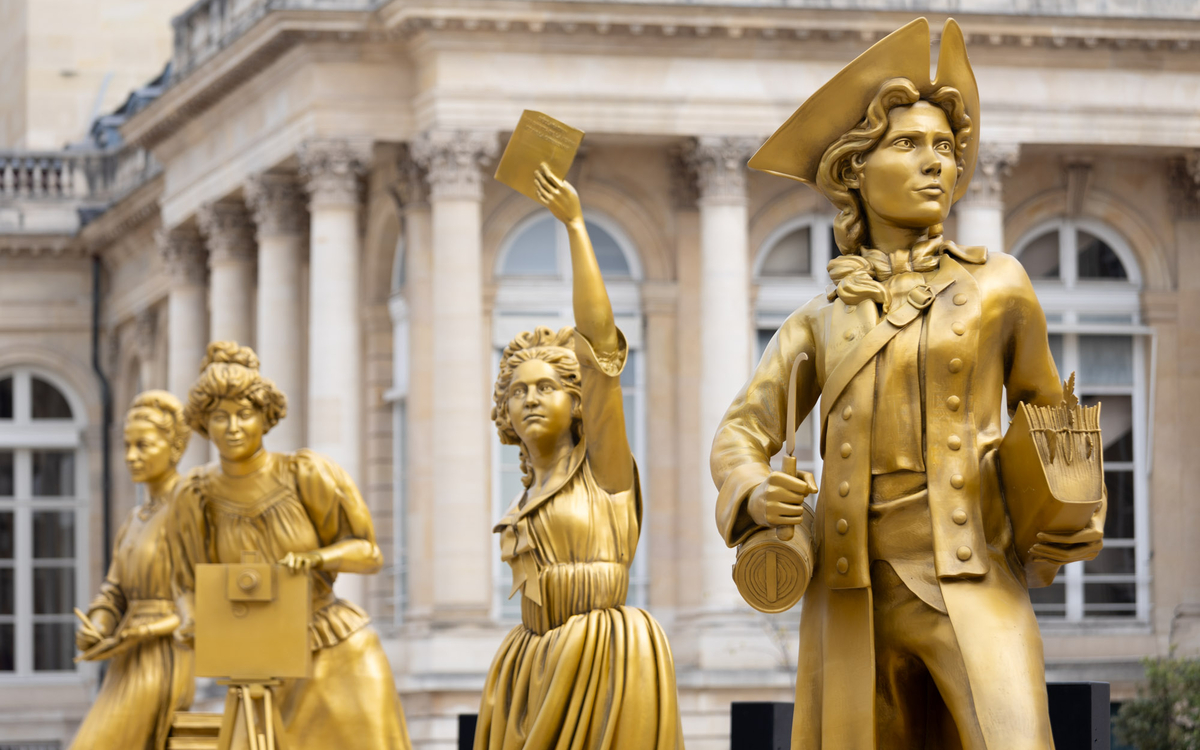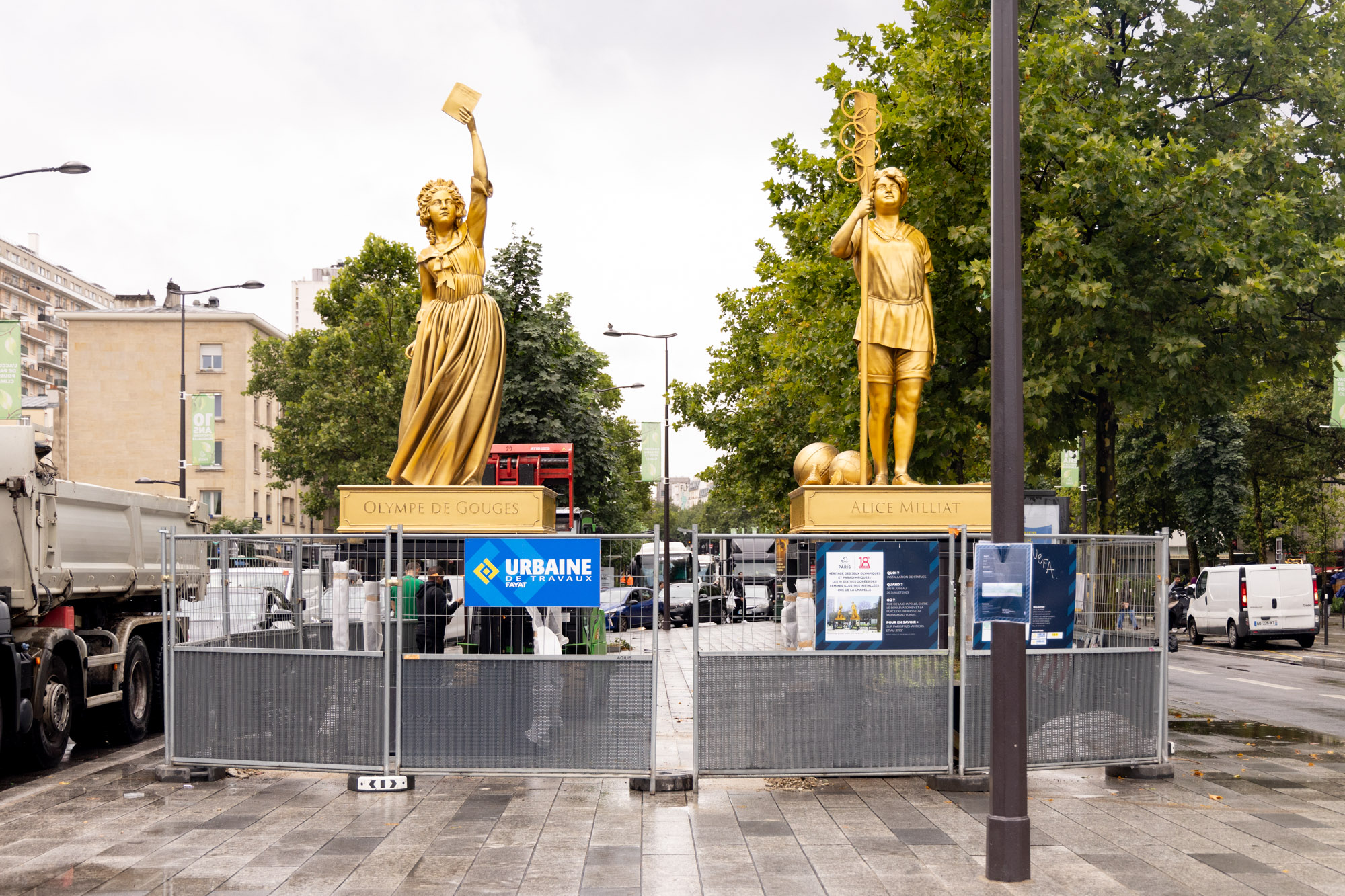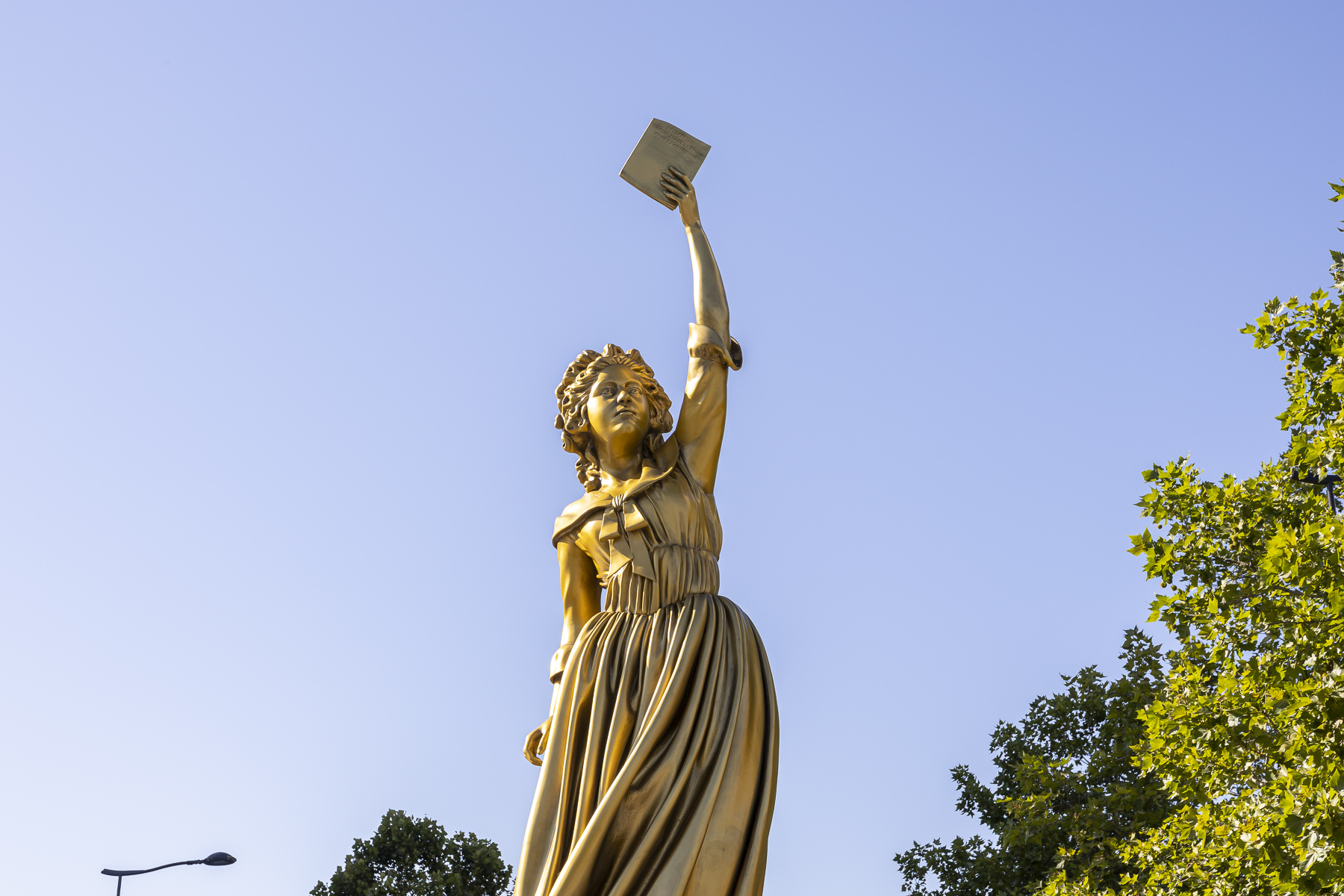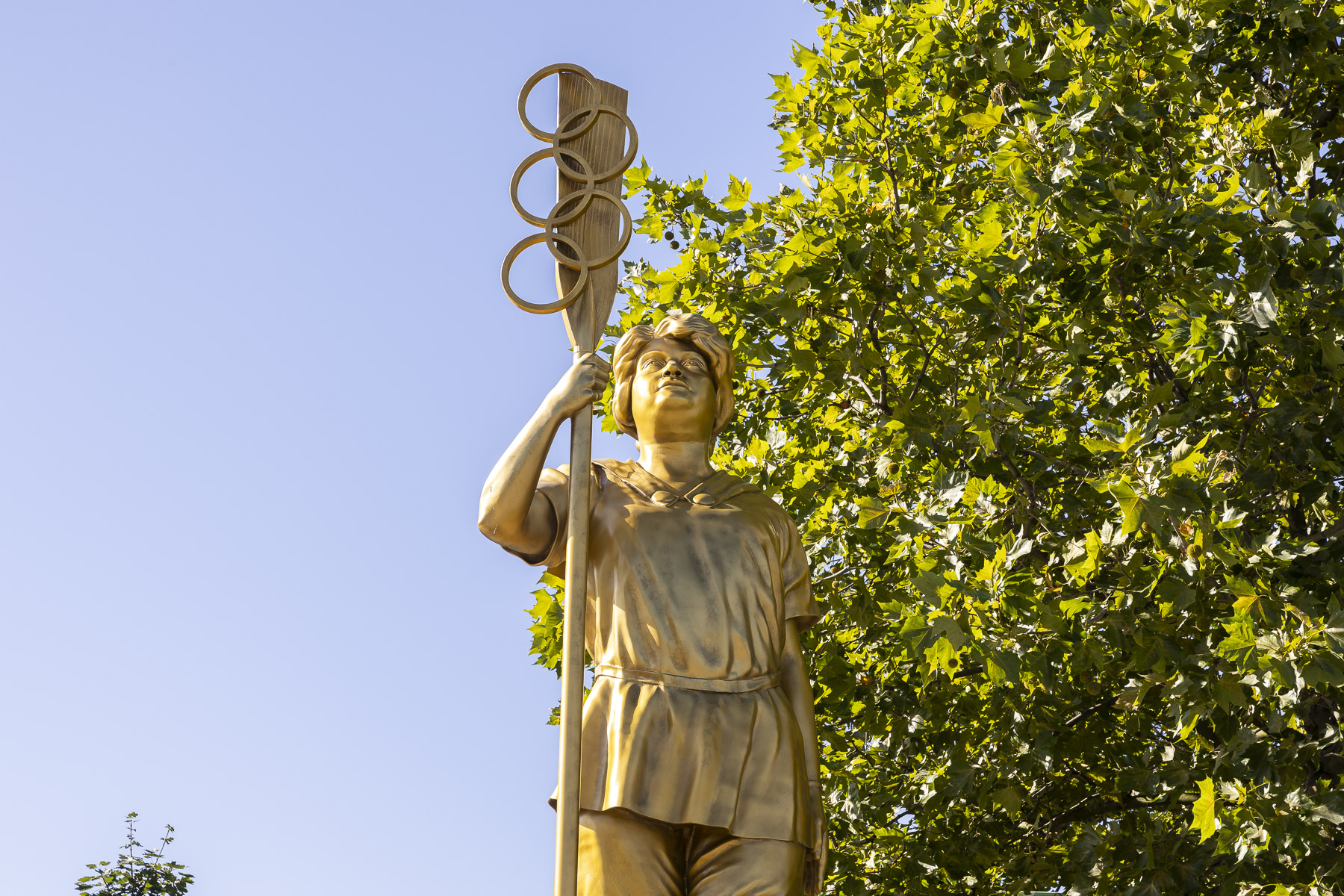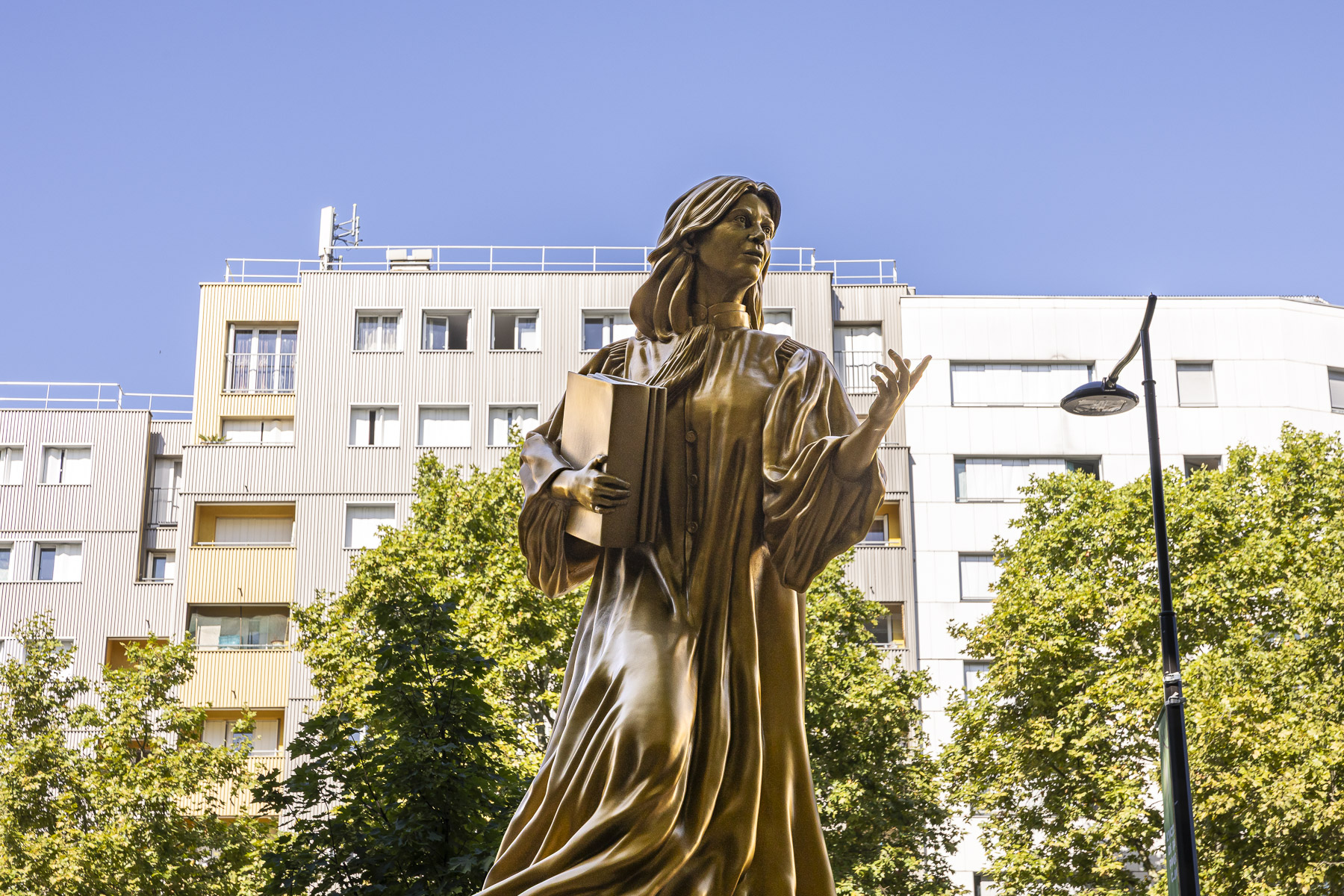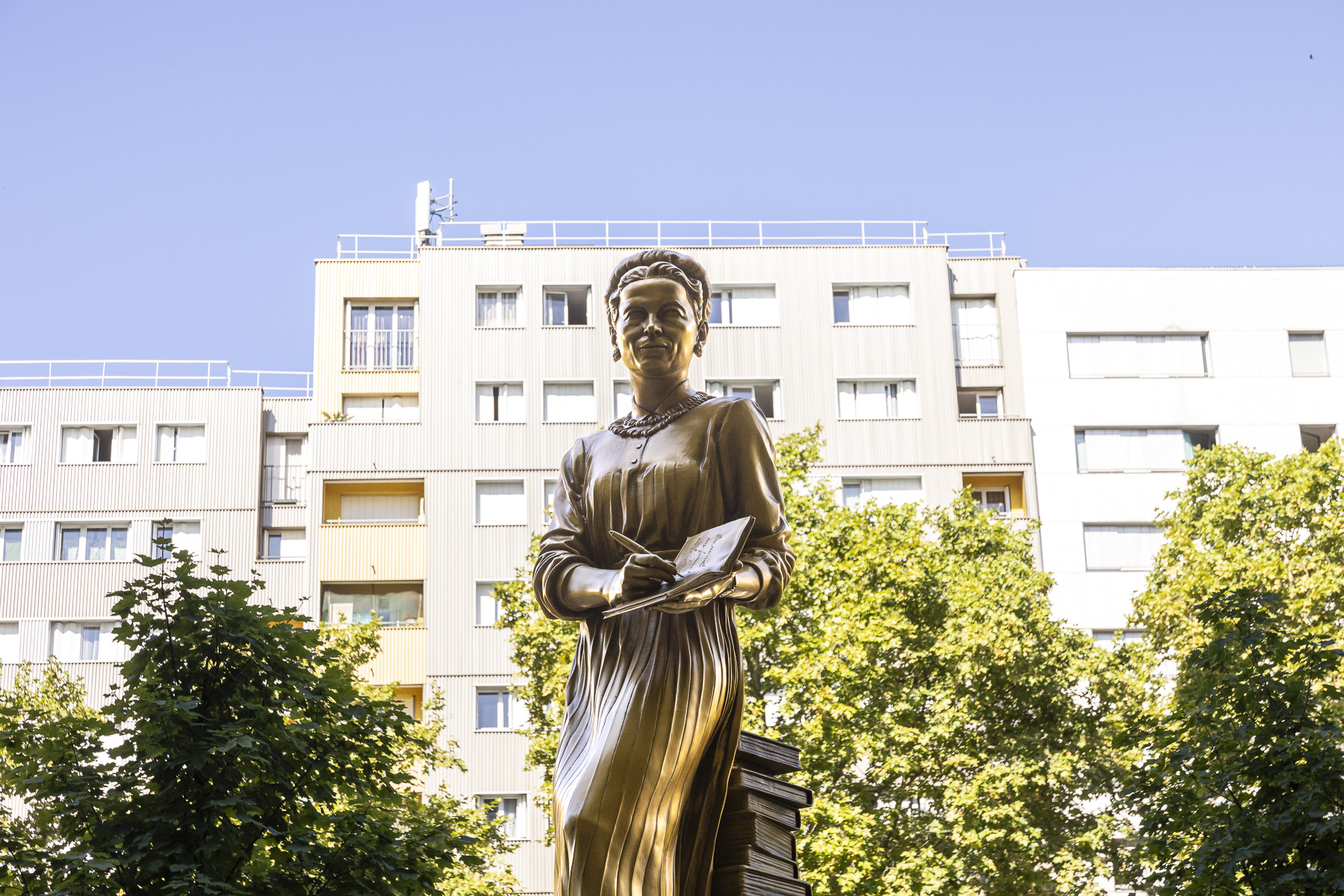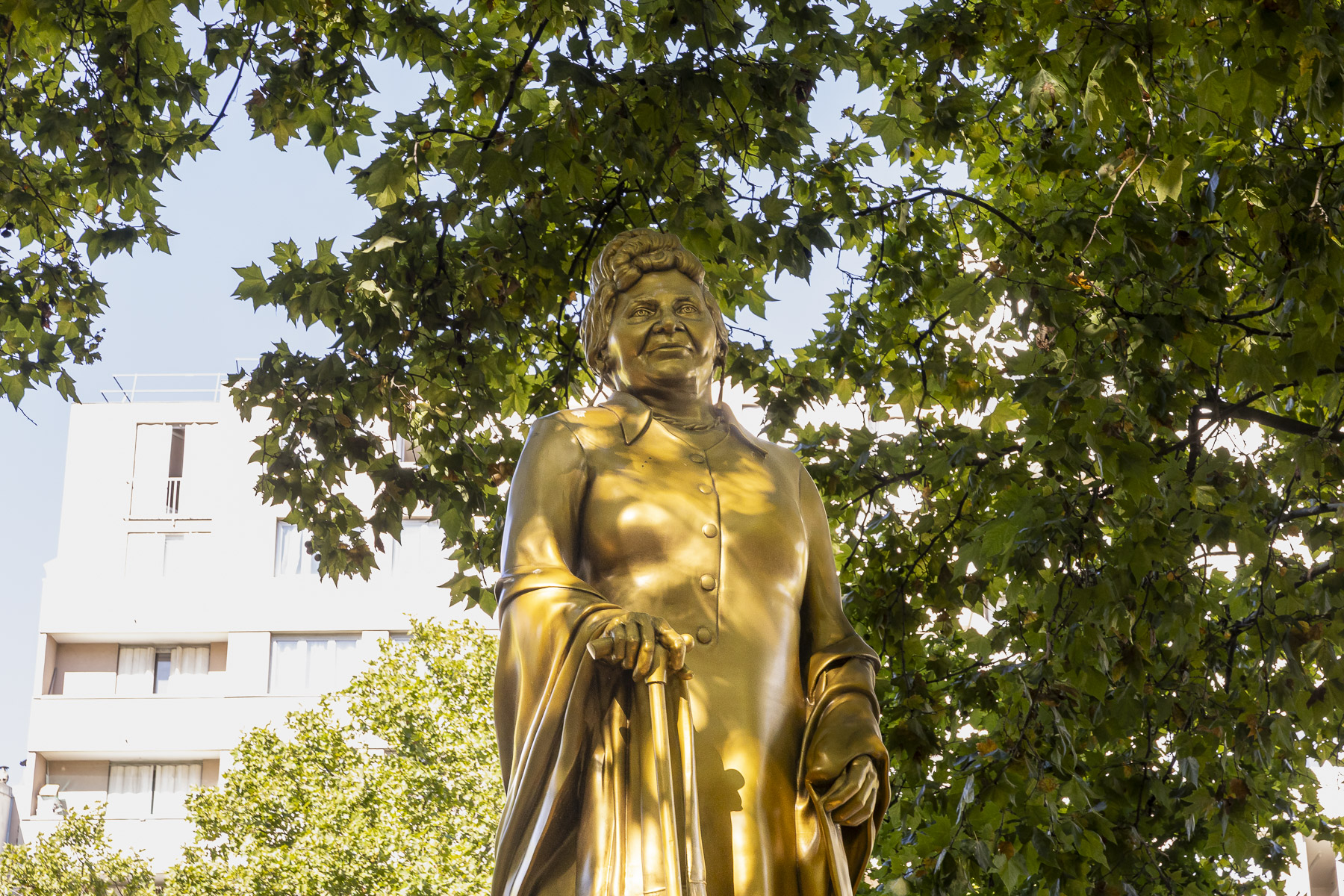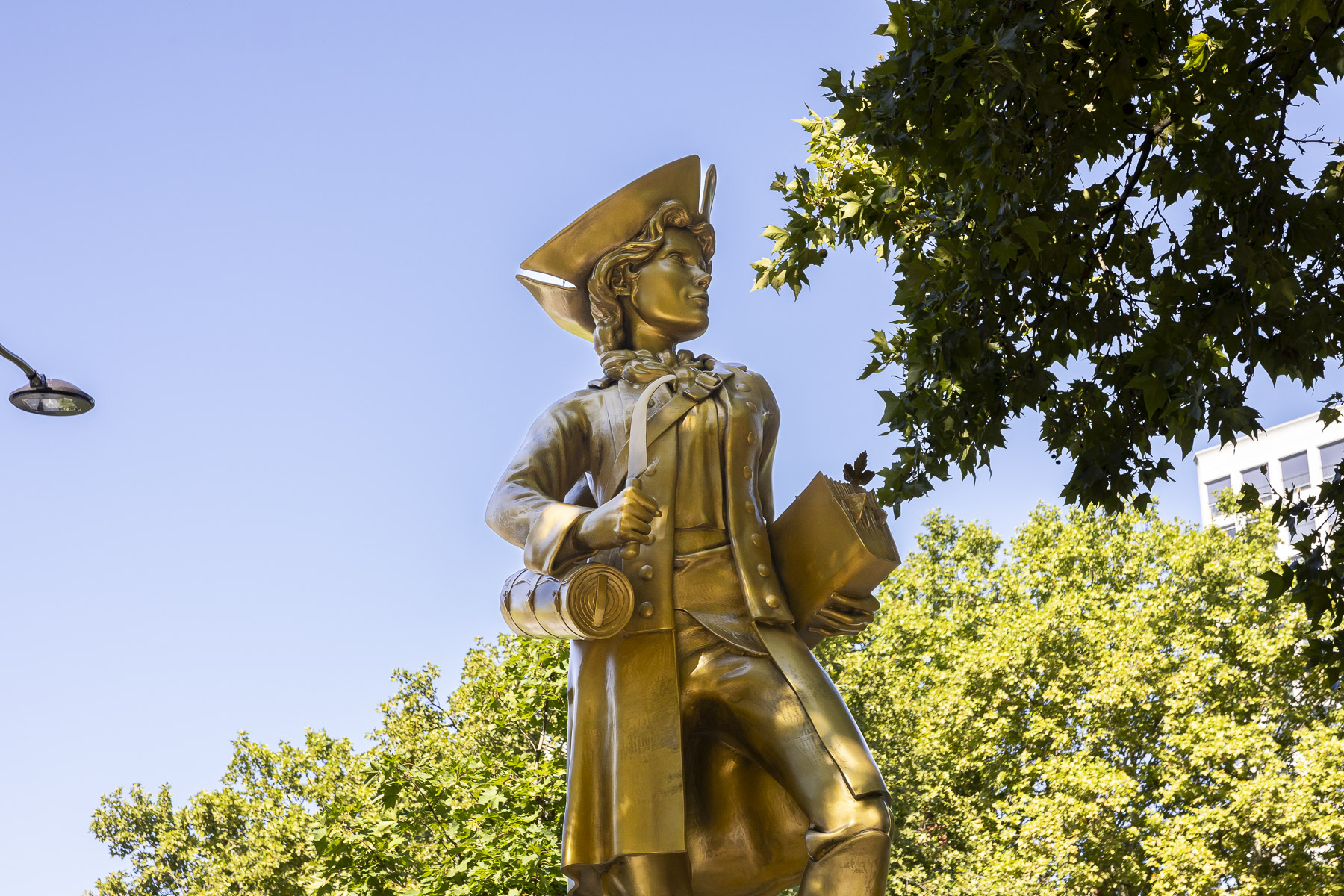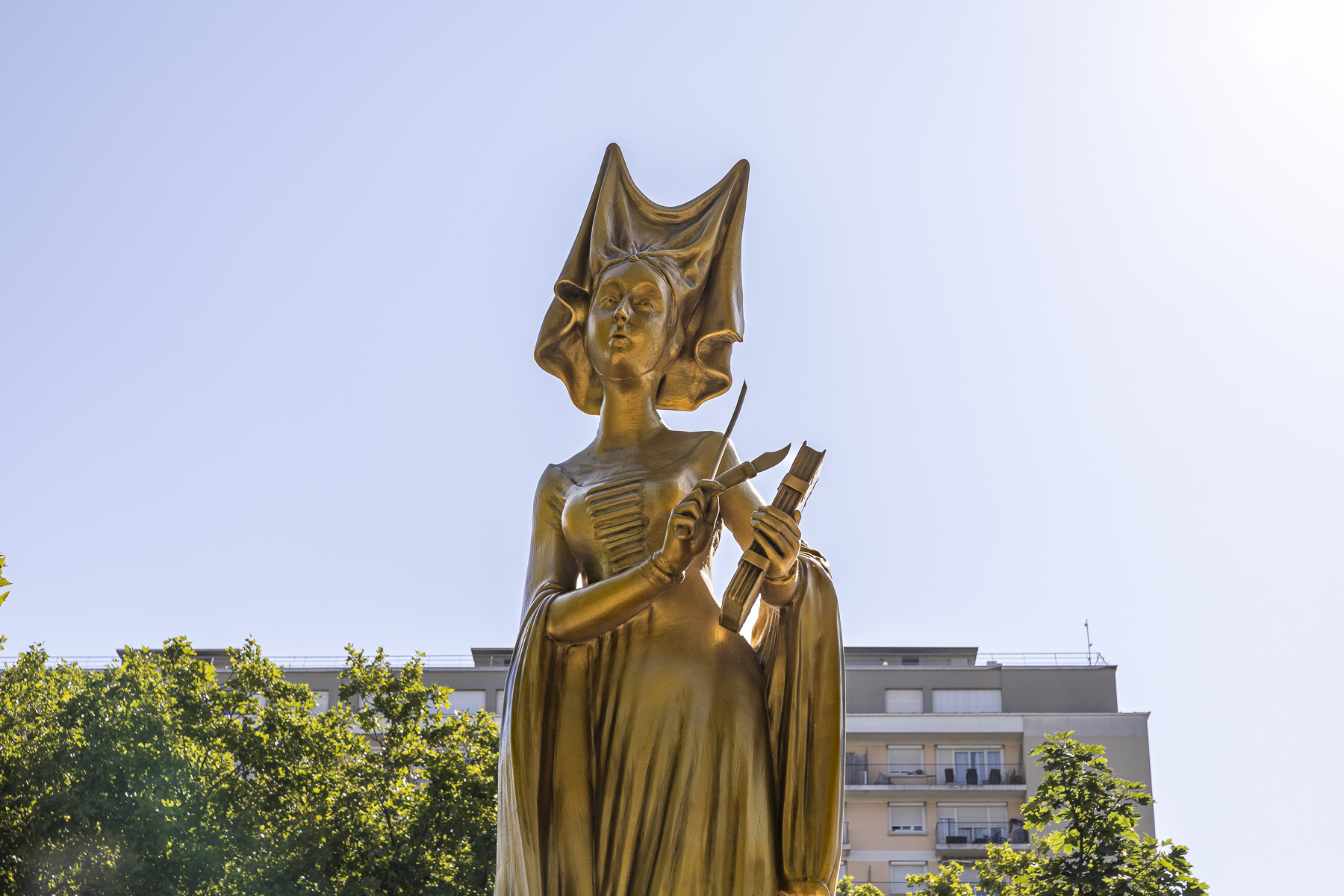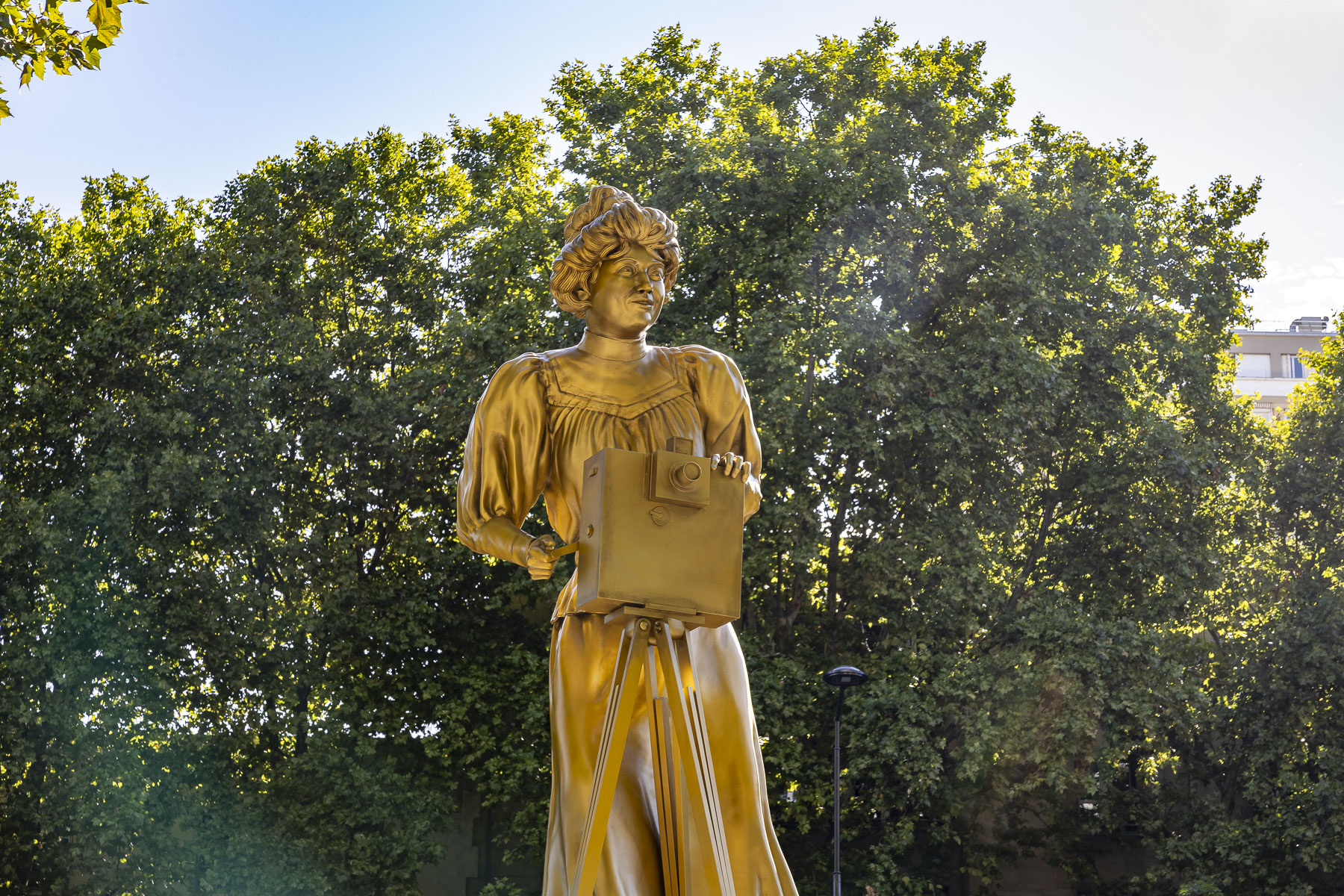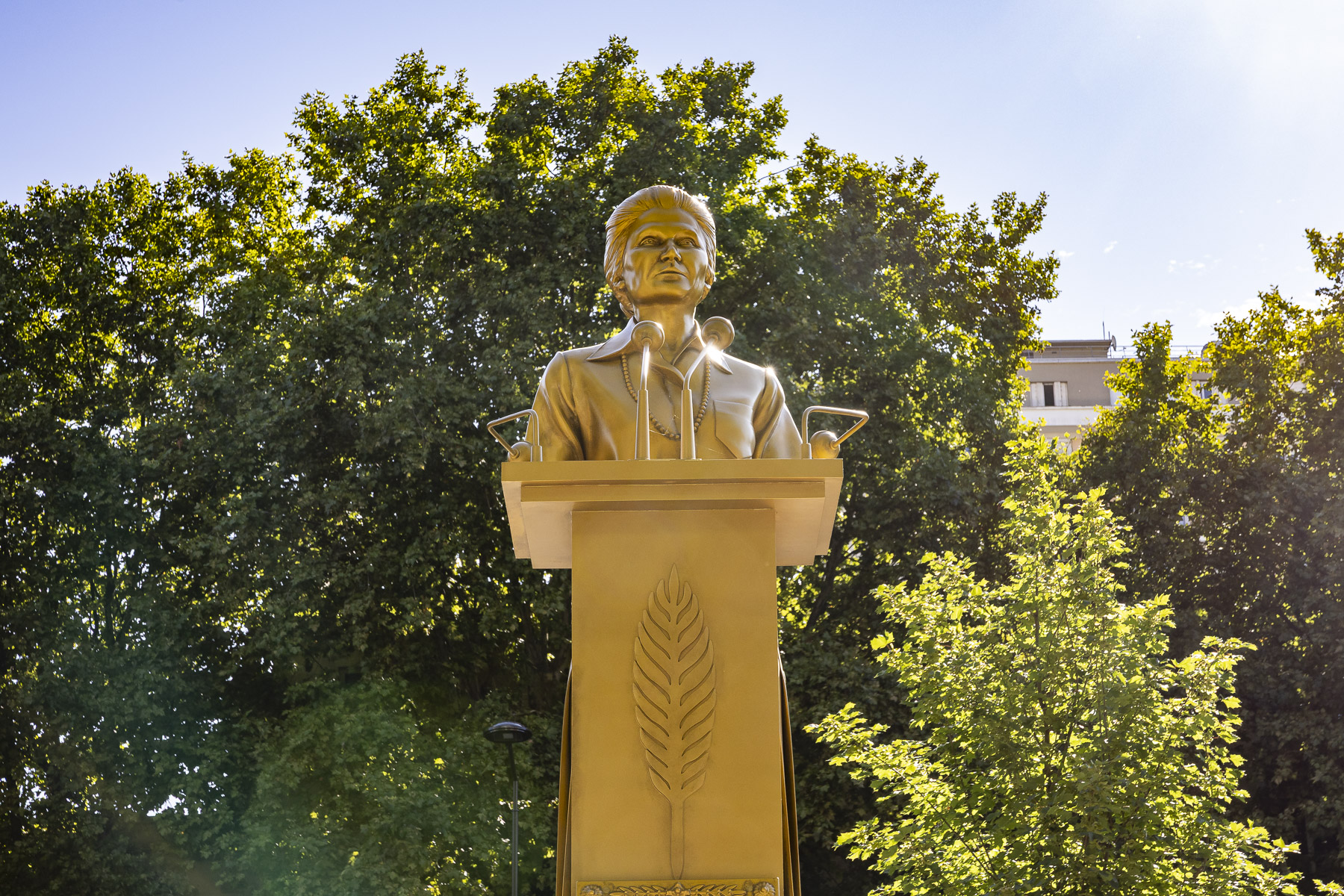Content
Cette page est aussi disponible en français
They will remain one of the unforgettable images of the Opening Ceremony of the Paris 2024 Olympic Games™ held on the Seine on 26 July 2024. Discover the portraits of the ten women whose statues are installed on rue de la Chapelle (18th arrondissement).
Right
from the bidding phase, the Mayor of Paris and the French Olympic movement
wanted to hold the Olympics in the heart of the city. This edition of the Games
was to be a grandiose event uniting elite athletes and ordinary fans, and open
to the whole country and its people. For the first time in the history of the
Olympic Games™, ground breaking and daring ceremonies brought athletes and
hundreds of thousands of spectators together, outside a stadium, in the heart
of an exceptional setting: Paris, its river and its historical monuments.
On 26 July 2024, for the opening ceremony of the Olympics, the Seine was
transformed into an open-air stage to set Paris, France and the whole world on
fire. The over 6km-long parade of athletes, combined with artistic performances
directed by the artistic director of the ceremonies for the 2024 Paris Olympics
Thomas Jolly, showcased Paris's heritage for the whole world to see. 326,000
spectators – equivalent to the capacity of five Stade de France stadiums –
attended this memorable ceremony on the banks of the Seine, and several billion
more watched from home. Far from the image of an inward-looking country, the
opening ceremony showed a France proud and rich in its diversity.
The gilded statues of the ten women honoured represent female figures
who have left their mark on French history in the fields of sport, the arts,
literature, law, politics and science. These monumental statues emerged along
the Seine, at the foot of Pont Alexandre III, accompanied by Axelle Saint-Cirel
singing La Marseillaise from the roof of the Grand Palais. The spectacle,
entitled “Sororité” (Sisterhood), was thought up by Thomas Jolly to pay tribute
to the feminist struggle.
Their contribution to the world, sometimes unrecognized, often attenuated or unjustly omitted, is now a matter of public record.
artistic director of the ceremonies for the Paris 2024 Olympic Games
Ten sculptures of illustrious women
The
Mayor of Paris wanted these ten sculptures to be installed for all to see, in
Paris’ public space, and more specifically Porte de la Chapelle (18th
arrondissement), in an area that was transformed in preparation for the
Olympics.
Rue de la Chapelle was turned into a vast promenade and now benefits
from the same facilities as the capital's main avenues (cycle lanes, reduced
space for cars, greenery, new street lighting, etc.). The rue leads to the
Porte de la Chapelle Arena, Paris' new 8,000-seat arena, which hosted the
badminton, rhythmic gymnastics, para-badminton and para-weightlifting events at
the Paris 2024 Olympic and Paralympic Games. The transformation of this
emblematic gate in north Paris is an integral part of the legacy of the Games,
which responds to a concrete need of local residents and regions.
Installation of the statues of the "ten golden women" of the Olympic Games in the Chapel.
Crédit photo :
Jean-Baptiste Gurliat / Mairie de Paris
The installation of these ten pioneering women on the streets of Paris
is part of Ville de Paris' proactive policy to strengthen the representation of
women in Parisian public spaces. As such, these statues are part of the iconic
legacy of the first Olympic Games to achieve full gender parity – Paris 2024
was the first Games to be held with as many women as men, whether as Olympic
athletes, volunteers, Marathon pour Tous runners or torchbearers. A nod to the
past, as it was in Paris in 1900 that the Olympic Games opened its doors to
women for the first time.
These fibreglass-reinforced polymer resin sculptures are nearly four
metres tall.
Make way for these ten women, who will tell you all about their
illustrious journey through French history.
This tour is on loan free of charge from the International Olympic
Committee and BPCE.
Other:
-
This tour is available in audio description using a QR code installed on the right-hand post of the base of each statue.
-
Ville de Paris would like to thank the International Olympic Committee and BPCE, a partner of the Paris 2024 Games, for lending this statue free of charge. It can be found on rue de la Chapelle (18th arrondissement) as part of the legacy of the Paris 2024 Games.
-
The reproduction, even partial, of this work is strictly forbidden without authorisation. If you notice any illegal use, please contact: sollicitations.paris.fr. Any use must be the subject of a prior request to the International Olympic Committee and BPCE.
Olympe de Gouges (1748-1793) - Woman of letters and politician
Born in Montauban in 1748, Marie Gouze moved to Paris in 1773. As Olympe de Gouges, she created a theater troupe and wrote her first texts. In 1784, she wrote a play denouncing slavery, Zamore et Mirza ou l'Esclavage des Noirs. But it wasn't until the French Revolution that the play was performed at the Comédie-Française. Olympe de Gouges pursued her literary career with new publications: plays, novels and essays. She confirmed her commitment to denouncing slavery by publishing her Réflexions sur les hommes nègres (Reflections on Negro men) and by frequenting the leaders of the Société des amis des Noirs (Society of Black Friends).
During the Revolution, she published a number of pamphlets and texts plastered on the walls of the capital, addressing issues such as the status of married couples, unemployment and taxation… But it was above all through her Declaration of the Rights of Women and the Citizen, addressed to Queen Marie-Antoinette in September 1791, that she remained famous and left her mark on the history of feminism. The first of its seventeen articles proclaims, on the model of the 1789 Declaration of the Rights of Man and of the Citizen, that "woman is born free and remains equal in rights to man". It calls not only for civil equality, but also for political rights and marital freedom for women.
She was arrested at the height of the Terror in July 1793, summarily tried and guillotined on November 3, on what is now Place de la Concorde.
"Woman has the right to climb the scaffold; she must also have the right to climb the rostrum."
Alice Milliat (1884-1957) - French swimmer, field hockey player and rower - World's first female sports leader
It was in London, where she lived for several years, that Alice Milliat, born in Nantes in 1884, discovered sports such as field hockey and rowing. Returning to France in 1908 after the death of her husband, she settled in Paris and became involved in the Femina Sport sports club, becoming its president in 1915. Driven by the desire to make all disciplines accessible to every woman, she initiated the first women's soccer match in France, in September 1917, as well as the first women's cross-country race, in April 1918. Denouncing the difficulty for women to take part in sporting competitions, and the impossibility of participating in the Olympic Games, she created the Fédération sportive féminine internationale (1921) and organized the first international competition, the "Jeux olympiques Féminins", at the Pershing stadium in Paris on August 20, 1922.
The same year, she became the first woman to win the Audax brevet for rowing 80 km in a light boat on the Seine within the time limit. The 1922 Women's World Games were followed by further editions every 4 years until 1934. These successes contributed to the inclusion of women's athletics at the Amsterdam Olympic Games in 1928.
Weakened by frail health, she had to face an increasingly difficult context: the organization of women's competitions was reformed in its governance, and state subsidies were falling. Faced with the rise of fascism in Europe, which further restricted women's rights, she was forced to withdraw from the women's sports movement in 1935. She died anonymously in Paris in 1957.
Gisèle Halimi (1927-2020) - Lawyer, activist and politician
After studying law in Paris, Gisèle Halimi began her legal career in 1949 at the bar in Tunis, the city where she was born and spent her childhood, and continued it at the Paris bar from 1956. Involved in the defense of members of the Algerian and then Tunisian Liberation Fronts, she made a name for herself in 1960 as counsel for Djamila Boupacha, a young Algerian militant accused of planting a bomb in an Algiers brasserie. She had been raped and tortured by French soldiers.
Another trial, in 1972, marked the history of feminism in France: Gisèle Halimi defended a 16-year-old girl who had confessed to having had an abortion after being raped. The "Bobigny trial" was an important step towards the decriminalization of voluntary interruption of pregnancy (1975). In 1978, in Aix-en-Provence, she represented two women who had been gang-raped. Once again, her commitment as a lawyer contributed to the progress made by the law in classifying rape as a crime (1980). Gisèle Halimi's civic and political mobilization did not stop at the courtroom. In her books, as a member of several feminist associations and as an elected representative, she relentlessly led the fight for women's rights, against racism and for the emancipation of peoples.
Simone de Beauvoir (1908-1986) - Philosopher and writer
Born in 1908 into a bourgeois Catholic family, Simone de Beauvoir studied at the Sorbonne. It was there that she met Jean-Paul Sartre. After passing the agrégation in philosophy at the age of 21, she taught for a few years before devoting herself fully to writing novels and essays. In 1945, together with Jean-Paul Sartre and Maurice Merleau-Ponty, she founded the journal Les Temps modernes, where the existentialist movement took root. She went on to write her own work, which won her the Prix Goncourt in 1954 for Les Mandarins, and was punctuated by a series of autobiographical stories, including Mémoires d'une jeune fille rangée (1958), La Force de l'âge (1960) and La Force des choses (1963).
Her essay Le Deuxième Sexe (The Second Sex), published in 1949, marked the history of feminism and earned her worldwide renown. A committed intellectual, notably against colonization during the Algerian war, she was an active campaigner for the feminist cause and signed the 343 manifesto for free abortion. Until her death in 1986, six years after Sartre's, she contributed to Les Temps modernes and continued her commitment to women's rights as editor of Nouvelles Questions féministes.
Paulette Nardal (1896-1985) - Intellectual, journalist and writer
The daughter of a schoolteacher and piano teacher and a Ponts et Chaussés engineer, himself the descendant of freed slaves, Paulette Nardal left Martinique in 1920 to study English. She was the first black woman to enroll at the Sorbonne.
In Clamart, with her sisters who had joined her in Paris, she ran a literary salon frequented by many writers and intellectuals from the West Indies, Africa and America, including Léopold Sédar Senghor, Aimé Césaire, Léon-Gontran Damas and the Jamaicans Marcus Garvey and Claude McKay. She wrote for La Dépêche Africaine, a newspaper denouncing inequalities in the colonies. In 1931, she co-founded and edited La Revue du monde noir, a bilingual publication at the theoretical forefront of Négritude.
She was seriously injured in 1939, when the ship she was returning from a stay in Martinique was torpedoed. She settled in Martinique in 1940, where she taught English. However, she did not give up her commitments: she created a Martinican feminist association and newspaper to mobilize women who had won the right to vote in 1945. At the end of the 1940s, she worked for a few months as the Antilles' representative to the UN. She then founded a choir and devoted herself to spreading negro spirituals in Martinique. It was not until the end of her life that her contribution to the emergence of black consciousness was recognized.
Jeanne Barret (1740-1807) - Explorer and botanist
Born in 1740 into a modest Burgundian family, Jeanne Barret was hired by physician and botanist Philippe Commerson in the early 1760s. She was soon assisting Commerson in his research. She became his companion and moved with him to Paris in 1764. There, Commerson rubbed shoulders with the most renowned scientists and, together with Bougainville, prepared an expedition to the southern lands.
When he embarked in 1767 aboard L'étoile, one of the expedition's two boats, he was accompanied by a valet, "Jean Barret", as the presence of women on board was forbidden. Disguised under this identity, Jeanne Barret took part in the crew's manoeuvres and worked with Commerson to study the flora and fauna of the still unknown territories covered by the expedition. Unmasked in Tahiti, Jeanne Barret continued the voyage as far as Mauritius. She then left the Bougainville expedition with Commerson, at the request of Intendant Pierre Poivre, himself a naturalist, to study the local flora and fauna. Together, they contributed to the creation of the Jardin botanique des pamplemousses on Mauritius.
Commerson died in 1773. Jeanne Barret had the notes and collections of plant species they had accumulated sent to France. Destitute at the time, she opened a cabaret in Port-Louis. She married in 1774 and returned to France a year later, completing a round-the-world voyage that she was the first woman to accomplish. Her merits and contribution to science were recognized by a grant from King Louis XVI, dated 1785.
Louise Michel (1830-1905) - Teacher, writer, anarchist and feminist activist
Louise Michel was born in 1830 at the Château de Vroncourt in Haute-Marne, where she received a solid and open education. She became a schoolteacher in 1852. At the same time, she published her first poems in the local press and corresponded with Victor Hugo. She moved to Paris in the mid-1850s, where she was active in republican, labor and feminist circles.
From September 1870, and the very first days of the Prussian siege of Paris, she was involved in the defense of the capital; then, after the armistice, which she experienced as a betrayal, she was again in the front ranks, in Montmartre, among the insurgents. She was a major player in the Paris Commune, proclaimed on March 28, 1871, as an ambulance driver, as a fighter and on the barricades, but also as a reformer, notably through her proposals on education. During Bloody Week, she decided to surrender to the enemy to free her mother, who had been arrested in her place.
Deported to New Caledonia in 1873, she took an interest in Kanak culture, denounced the conditions of colonization and set up a school open to Kanak children. In July 1880, the amnesty granted to the Communards enabled her triumphant return to Paris. Now a recognized figure, Louise Michel took up her torch as a militant and continued to defend the cause of women, workers and the colonized until her death on January 9, 1905.
Christine de Pizan (1364-1431) - Woman of letters
Born in Venice in 1364, Christine de Pizan was the daughter of Thomas de Pizan, a physician and astronomer renowned in Bologna, who moved to Paris in 1368, where he had been called to the court of Charles V. At the age of fifteen, she married the king's secretary, Étienne Castel, with whom she had three children. After her father's death, and then her husband's, left destitute, she took up writing at the age of twenty-five to support her family. She began by writing poems, then, having enriched her knowledge by reading and frequenting chancery circles, treatises on education, philosophical texts, historical studies, political reflections, and even a military treatise. His considerable body of work, both in terms of scope and diversity, enjoyed great success during his lifetime. She also contributed to the publication of her own works, supervising copies and offering them to patrons.
In many of her writings, she championed the cause of women, lamenting the inadequacy of their education and the precariousness of their situation in the event of widowhood. She asserts their intellectual competence and denounces men who slander women. In La Cité des dames, her best-known work, she traces the contribution of famous female figures, both historical and mythological, to the society and culture of their time, and even imagines a city built and inhabited solely by women. After the capture of Paris by the Burgundians in 1418, she took refuge in an abbey, where she died in 1430, without having given up her writing.
Alice Guy (1873-1968) - Film director, screenwriter and producer
Trained as a shorthand typist, Alice Guy began her professional career at the Comptoir général de photographie. As secretary to Léon Gaumont, she took an interest in cameras and began making her first short films in her spare time, including the highly successful La Fée aux choux, a fictional playlet. She was then put in charge of a department in charge of fiction film production.
Until 1907, she made several hundred films in Paris in a wide variety of genres, including Naissance, vie et mort du Christ en 25 tableaux, considered the first peplum in the history of cinema. The filmmaker was highly inventive, both in her narrative choices and in the creation of new gimmicks and technical innovations.
In 1910, she founded her own production company in New York, where she had been living for three years with her husband. Here, she continued her work as a filmmaker, both as director and producer. Westerns, cross-dressing comedies, action films - often led by a heroine -, shorts and features followed one another for several years. After her production company went bankrupt, Alice Guy tried her luck in Hollywood before returning to France in 1922, unable to resume her film career. It wasn't until the late 1950s that recognition of her work began.
Simone Veil (1927-2017) - Politician and magistrate
Arrested in 1944 at the age of 16 in Nice, then deported to concentration camps including Auschwitz and Bergen-Belsen, Simone Veil is a survivor of the Holocaust. Her parents and brother never returned. After the war, she studied law and passed the competitive examination to become a magistrate.
She went on to enjoy a brilliant career at the Ministry of Justice. Appointed Minister of Health in 1974, under the presidency of Valéry Giscard d'Estaing, she defended the law allowing reimbursement of the contraceptive pill and facilitating access to it for minors. On November 26 1974, she introduced the bill to decriminalize voluntary interruption of pregnancy (abortion) in the French National Assembly. Despite strong hostility from some deputies, the bill was adopted and came into force in 1975.
Equally committed to the construction of the European Union, Simone Veil was elected President of the first European Parliament to be elected by universal suffrage, from 1979 to 1982, and remained a member until 1993. Recalled the same year to the Ministry of Social Affairs, Health and Urban Affairs, she joined the Constitutional Council from 1998 to 2007. The following year, she was elected to the Académie française.
Attentive to all forms of suffering, she remained throughout her life a key witness and a tireless campaigner within numerous memorial institutions to keep alive the memory of the deportation of European Jews. She died in 2017, making her the fifth woman to be inducted into the Pantheon in 2018.
Where to see the statues on rue de la Chapelle?
Interested in Paris cultural news?
Default Confirmation Text
Settings Text Html
Settings Text Html
We want to hear from you!
Was this information useful to you?
Please note: we cannot reply via this form (please do not include any personal information).
